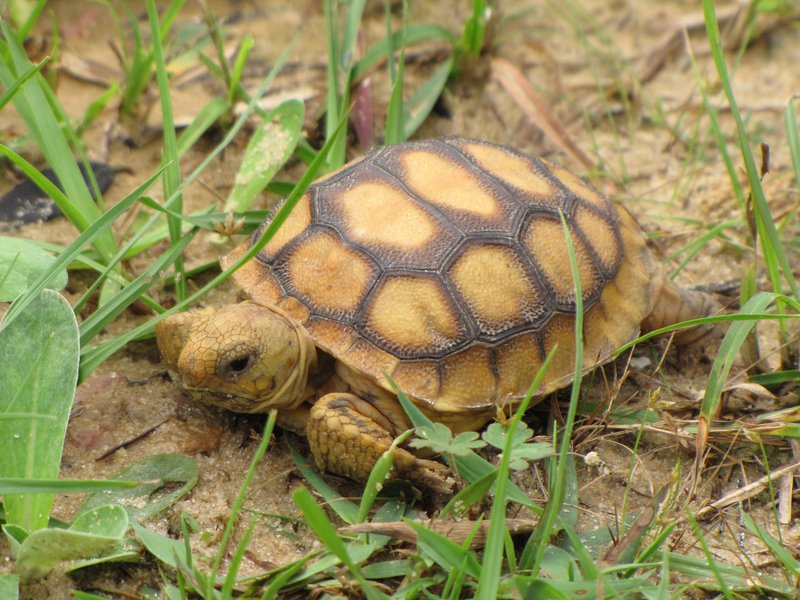For Immediate Release, August 9, 2023
|
Contact: |
Elise Bennett, Center for Biological Diversity, (727) 755-6950, ebennett@biologicaldiversity.org |
Lawsuit Challenges Denial of Endangered Species Protection to Gopher Tortoise
Tortoise Threatened by Habitat Destruction, Fragmentation Across Southeast
ST. PETERSBURG, Fla.— The Center for Biological Diversity and Nokuse Education, Inc. sued the U.S. Fish and Wildlife Service today for denying Endangered Species Act protections to gopher tortoises across most of their range. The decision left the imperiled reptiles without lifesaving federal safeguards in Florida, Georgia, South Carolina and most of Alabama.
“Gopher tortoises will stay on a collision course with extinction until they get the strong Endangered Species Act protections that they’re entitled to,” said Elise Bennett, Florida director and an attorney at the Center for Biological Diversity. “The Service got it wrong when it denied these gentle creatures protection. We’re bringing this case because gopher tortoises and the hundreds of other species that rely on them for survival are worthy of our care and concern.”
The Service denied protections in late 2022 despite originally finding in 2011 that the tortoise warranted protections — and despite its own projections that nearly three-quarters of remaining gopher tortoise populations will be lost over the next 80 years. Even this projection fails to account for the full effect of habitat destruction on this highly vulnerable species.
“Our organization has been committed to saving the gopher tortoise for over 20 years and during that time we have witnessed a steep decline in gopher tortoise populations and habitat,” said Matthew Aresco, board member at Nokuse Education, Inc. “There is no question that if we fail to increase the protection of this long-lived, iconic species, it will fade away and face extinction. The Service’s own analysis predicts a dire outlook for the survival of the gopher tortoise, yet they failed to follow the best available science in their decision and list the species under the Endangered Species Act.”
Gopher tortoises have shovel-like front legs and strong, thick back legs that help them dig deep, and intricate burrows, which more than 360 other species use. Gopher tortoise burrows are considered key features in the large, unfragmented upland ecosystems these communities of wild animals need to survive.
Gopher tortoises have already lost 97% of the longleaf pine savannas they historically inhabited and continue to be severely threatened by habitat loss and fragmentation driven by urbanization. This limits food availability and options for burrow sites, which exposes them to being crushed in their burrows during construction, run over by cars or senselessly attacked by people. Tortoises are also threatened by disease, invasive species like fire ants, and climate change.
Characteristics such as delayed sexual maturity, dependence on high adult survival rates and high levels of nest and hatchling mortality make gopher tortoises especially vulnerable to human-driven threats. The presence of long-lived adult tortoises can also mask serious population problems like reproduction declines or failure.
Some states have implemented limited protections for gopher tortoises, but they have not stopped or reversed the species’ ongoing decline. For example, Florida requires that most tortoises be relocated away from development, but the state does not equally protect tortoise habitat. This means that the creatures are being squeezed into increasingly smaller areas. Combined with booming development this has led to shortages of suitable places to put relocated tortoises.
Moving tortoises, rather than protecting their habitat, also harms hundreds of other species that rely on them to thrive, disrupting entire natural systems.
Gopher tortoises in limited parts of Louisiana, Mississippi and western Alabama are protected under the federal Endangered Species Act. Those in eastern Alabama, Florida, Georgia and South Carolina have been waiting for federal protection since 1982.

The Center for Biological Diversity is a national, nonprofit conservation organization with more than 1.7 million members and online activists dedicated to the protection of endangered species and wild places.
Nokuse Education, Inc. is a non-profit education and conservation organization and operates the E.O. Wilson Biophilia Center, an environmental education center in Walton County, Florida. The core mission of Nokuse Education, Inc. is to educate students and visitors on the importance of biodiversity, to promote sustainability, and to encourage conservation, preservation, and restoration of ecosystems. Nokuse is actively involved in gopher tortoise conservation efforts through habitat acquisition, restoration, and management.

